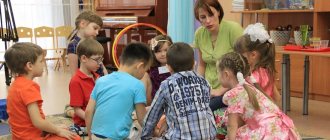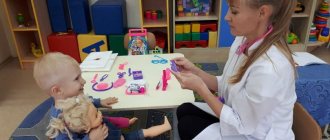Excerpts from one of the parent forums:
“Does anyone have these blocks? Do children like it or do they use it for the most - building houses? I'm wondering whether to order such a box or not? Will they just scatter it all over the apartment again?”...
*
“In my opinion, it’s not necessary. These blocks are good to use in classes in kindergartens, otherwise there is little interesting in them, geometric figures and that’s all.”
Well what can I say? You can scatter anything...
What are logical blocks? And why are they needed?
In many countries around the world, the didactic material “Logic Blocks”, developed by the Hungarian psychologist and mathematician Dienes, is successfully used to develop logical thinking in children.
Over the past decade, this material has been gaining increasing recognition among teachers and parents in our country. You can purchase LBD at an educational games store.
Dienesh's logic blocks are a set of 48 geometric shapes:
a) four shapes (circle, triangle, square, rectangle);
b) four colors (red, blue, yellow);
c) two sizes (large, small);
d) two types of thickness (thick, thin).
Each geometric figure is characterized by four characteristics: shape, color, size, thickness. There is not a single identical figure in the set.
Many logic games use cards with property symbols. Introducing a child to property symbols is an important step in mastering the entire sign culture, literacy, mathematical symbols, programming, etc. The cards conventionally indicate the properties of the blocks (color, shape, size, thickness). There are 11 cards in total. And 11 cards with the negation of properties, for example: Not red.
Unfortunately, there are no such cards in the store set, but they can be downloaded.
Dienesh's blocks are a universal educational game. Kids love playing with blocks! As the experience of Russian teachers in working with children from 2 to 10 years shows, games with logic blocks allow you to:
* Introduce the shape, color, size, thickness of objects.
* Develop spatial understanding.
* Develop logical thinking, the idea of a set, operations on sets (comparison, partitioning, classification, abstraction, encoding and decoding of information).
* Master the basic skills of an algorithmic culture of thinking.
* Develop the ability to identify properties in objects, name them, generalize objects by their properties, explain the similarities and differences of objects, justify their reasoning.
* Develop cognitive processes, mental operations.
* Foster independence, initiative, and perseverance in achieving goals.
* Develop creativity, imagination, fantasy, modeling and design abilities.
* Develop speech.
* Successfully master the basics of mathematics and computer science.
A few words about Zoltan Gyenes
Zoltan Pál Dienes has been interested in mathematics since childhood, so there is nothing strange in the fact that he decided to devote his entire life to the “queen of the exact sciences,” as well as its popularization not only in his native Hungary, but throughout the world. Already at the age of 23, Zoltan received a doctorate in mathematics, but did not rest on this and continued his education. In order to understand the mental processes involved in solving mathematical problems, he received an additional degree in psychology.
For most of his professional career, Dienes studied psycho-mathematics (for more than 10 years he headed the Center for the Study of Psycho-Mathematics at the University of Sherbrooke). Based on his own practical experience and the results of numerous studies, he developed a unique proprietary program for studying mathematics , accessible to children of various age categories.
Zoltán Dieneš's methodology is based on various logic games, exciting mathematical tasks and educational teaching aids aimed at stimulating children's interest in mathematics, as well as the development of combinatorics, logical thinking, analytical abilities, speech, memory and attention.
How to play with LBD?
There is a small manual in the box with the blocks, which is very schematic. You can get acquainted with logical blocks in detail using the books: “Let's Play” (edited by A.A. Stolyar. - M., 1991, 1996), as well as “Logic and Mathematics for Preschoolers” (edited by Z.A. Mikhailova - St. Petersburg, 1996, 2000).
I will share my own experience of working with children as a methodologist - practice manager and home teacher.
All games and game exercises can be divided into 4 groups with gradual complication:
- to develop the skills to identify and abstract properties;
- to develop the ability to compare objects according to their properties;
- for the development of classification and generalization actions;
- to develop the ability to perform logical actions and operations.
All games and exercises, with the exception of the fourth group (logical), are not addressed to a specific age. After all, children of the same calendar age can have different psychological ages. Some of them reach the next stage in intellectual development a little, and some much earlier than other peers, but everyone must go through all these steps. If the child cannot cope with the task on his own, then it is necessary to simplify the task, and so on until the child solves the problem. An independent and successful decision will be the step from which you should start moving forward.
If you keep children at a certain level or give them more complex games and exercises prematurely, then interest in activities will disappear. Children are drawn to mental tasks when they are difficult for them, but doable.
It is good for an adult to become an equal partner during games. He didn’t edify, he played! Before starting games and exercises, let the child independently use them at his own discretion in games. As a rule, children are happy to build something out of them. During such games with blocks, the baby will establish that they have different shapes, colors, sizes and thicknesses. When communicating with a child, it is better to use the word “figure” than the word “block”.
Features of the Dienesh system
Zoltan Dienes's method includes six interconnected stages of studying mathematics, which take into account the psychological aspects of solving mathematical problems.
The first stage is free play, during which children try to solve an unfamiliar problem by trial and error, trying out different solutions.
The second stage is studying the rules of the game, with the help of which the necessary mathematical information is “conveyed” to children.
The third stage is a comparison that allows you to diversify games with a similar rule structure with different materials, and thereby come to the understanding that changing the material does not change the essence of the game.
The fourth stage is familiarization with the content of numbers, thanks to which the child begins to understand the essence of the game and the common component of all mathematical games.
The fifth stage is symbolic, which includes the description of game cards using symbols, for which the child can come up with his own symbolic systems.
The sixth stage, formalization, consists of considering several options for describing game cards, as a result of which the child understands that the initial description can be an axiom, and his own conclusions can be a theorem.
Let us emphasize that Dienesh’s method completely excludes solving mathematical problems in notebooks or studying mathematical rules in boring textbooks. All activities are fun games, songs and dances during which children easily and quickly acquire mathematical knowledge and skills, and also get their first understanding of such complex mathematical concepts as algorithms, logical operations and information coding. At the same time, children, most often, do not even realize how complex concepts they are mastering in the course of exciting classes according to the “new mathematics” program of Zoltan Dienes .
Disadvantages of the Dienes system
Strange as it may seem, experts did not find any shortcomings in Dienesh’s system . However, studying the reviews of parents who are already engaged in this system made it possible to identify such shortcomings as:
- Limited color variety in Dienes blocks;
- For older kids who solve more complex problems, one set of Dienesh blocks is sometimes not enough;
- The concept of “thickness” is incorrect, as a result of which it is sometimes difficult to explain to a child, for example, why a square is always flat;
- In Russia it is quite difficult to find albums for classes using the Dienesh system.
Subscribe to our Telegram to stay up to date with important news in the field of education.
How are classes conducted according to the Dienesh system?
Classes using the Dienesh method include:
- games with the so-called Dienesh blocks, among which there are tasks for children of various age categories. For example, for young children (about 3 years old), the game “this way - not that way” is ideal (figures of different shapes, colors and sizes are laid out in front of the child, among which he needs to find “such or not like” figures, in accordance with shown by an adult example). For older children, you can choose a game of translator, during which you need not only to find this or not such a figure, but also to explain how one figure differs from another.
- games with hoops - allow you to master and consolidate spatial orientation skills. To do this, parents place two (or more) hoops of different colors on the floor so that they intersect (like the Olympic rings). The child needs to place a figurine of a given format inside the blue... outside the red... outside the blue and red hoop. The more hoops, the more task options there can be.
- the fabulous country of Ruritania - the mischievous twins Alice and Bruce live there, with whom children have the opportunity to take part in fascinating stories and plunge into the world of geometry and algebra.
During the lessons, kids study geometric shapes and parameters of objects in a light playful way, acquire the skills of comparing and analyzing diverse information, create mathematical models, logical chains and series, and also learn to make the necessary decisions.
Games with Dienesha blocks for the older group
When the child grows up, he will be able to click the exercises for kids like seeds, and the tasks will have to be complicated. Dienesh's method for preschoolers is designed for children 5-6 years old. The exercises are more complex; not only the cubes themselves are actively used, but also cards and game albums. The tasks are aimed at developing logical thinking in an adult child and the ability to explain the decision made. Study a few games as examples, based on which you can come up with many more exercises.
Search
Give your child any figurine of Dienesh or offer to choose one yourself. Then, from the total mass of blocks, he will take out all those that coincide with the first one in one given property. Once he has mastered the game well, make it more difficult. Let the child select blocks that have two identical properties to the one originally taken. Then you can make the game even more difficult. The child must choose those blocks that do not have a single adjacent property with the first one.
Domino
This game is suitable even for several children. Rules:
- Each player receives an equal number of blocks. The order of participants is determined.
- The first one makes a move with any piece.
- The second one places a block that has one of the same properties.
- If there is no suitable piece, the participant misses a move.
- The first one to lay out all his blocks wins.
- The game can be complicated by changing the rules about the properties of the pieces being laid out. For example, you need to respond with a block that has two similar characteristics, etc.
Find the odd one out
The following game will help children learn to group three-dimensional geometric shapes according to various criteria. Rules:
- Place three figures in front of the child. One of them should not have a single property in common with the others.
- Let the child figure out which block is extra and explain why and how he came to this conclusion.
- Make the task more difficult. Lay out 6 blocks. The baby must remove the extra two.
Find a match
This game will appeal to children who have already mastered all the simple tasks well. Rules:
- Place several figures in a row in front of your child.
- Offer to select a steam room for each according to a specific property.
- Make the task more difficult. Let the child try to choose a pair based not on one, but on two or three properties.
- You can initially take, for example, 10 paired elements. Place them in a bag. Let the child make the pairs himself, laying out the Dienesh figures in two horizontal rows.
Artists
To play the game you will need several large sheets of colored cardboard. They serve as sketches of paintings. To compose the composition, additional cardboard parts are needed. The game teaches you to analyze the shape of objects, compare them, and develops creative and artistic abilities. Rules:
- Based on the sketches, the kids must “paint” a picture.
- They choose the preparation themselves. It shows schematically where which blocks should be located. Thin ones will only be outlined, and thick ones will be completely painted over.
- Let the children select the missing blocks and parts cut out of cardboard to the correct places in the “sketch”.
Shop
For this task you need cards with images of objects that will serve as goods, and logical elements. The game “Shop” develops memory, the ability to reason, justify your choice, identify and abstract properties. Rules:
- A preschooler comes to a store that has a variety of card products. He has three figures that perform the function of money. You can purchase one item for each.
- The child needs to buy an object that has at least one property that matches the money figure.
- You can gradually complicate the game by offering new rules.
Let's decorate the Christmas tree
The following game helps develop the skills of ordinal counting and diagram reading. For it you will need an image of a Christmas tree and 15 cards with symbols and blocks. Rules:
- The Christmas tree should be decorated with beads in five rows. Each will contain three beads.
- The number on the card is the serial number of the position of the thread from top to bottom. The circle painted on it shows which number the bead should go, and below it indicates which element will represent it.
- Let the child hang the first row of beads, and then all the lower ones, strictly following the diagram on the card.
Dienesha blocks for the little ones
Children from the age of two can practice logical figures. Many simple games have been developed for them. Their main goal is to teach the child to distinguish between the properties of an object and to group objects according to certain characteristics. Such activities will not only be useful, but also interesting for every child. Check out some of the most popular game options.
Samples
These are the simplest games for kids who are just getting acquainted with the Dienesh set. Example:
- Place the elements of Dienesh in front of the child.
- Let him group them according to different criteria. First he selects everything of the same color, then size, etc.
Gradually the game becomes more difficult. Invite your child to sort blocks according to two or more criteria. For example:
- Choose yellow rectangular blocks and blue square ones.
- Get all the flat figures of the same size.
- Choose thin round blocks.
- Sort out all the blue triangle shapes.
Construction
All children, without exception, adore this creative game. It is very simple, but fascinating. The child is asked to put together different figures from the elements of Dienesh, first according to the diagrams, and then without them, gradually complicating the task. Examples of objects you might be asked to construct:
- house;
- table;
- house with windows;
- herringbone;
- shop;
- stool;
- sofa;
- chair;
- steps;
- armchair;
- machine.
Continue the series
The game is aimed at strengthening the child’s knowledge of geometric shapes, size, thickness, and color. Thanks to her, he will learn to find patterns. Task options:
- Place the elements of Dienesh on the table in front of the baby so that each next one differs from the previous one in one way. The child independently continues this series.
- Lay out a chain of Dienesh figures so that there are no objects nearby that are identical in two respects. Invite your child to continue this series.
- Place Dienesh figures in front of the baby by color: red, yellow, blue. He will continue the series, alternating shades in a given sequence.
Feed the animals
Place several of his favorite toys in front of your baby. Let him feed each one a pair of “cookies” (blocks). Offer some conditions, for example, the bear cub should be given only red food, and the kitten should be given square food. This game resembles sampling, but children perceive it much better. It’s rare that any child refuses to feed their pets.





